_edited.jpg)
Pop Art - III
Allan D'Arcangelo
1930 – 1998

Allan D'Arcangelo
(June 16, 1930 – December 17, 1998) was an American artist and printmaker, best known for his paintings of highways and road signs that border on pop art and minimalism, precisionism and hard-edge painting, and also surrealism. His subject matter is distinctly American and evokes, at times, a cautious outlook on the future of this country.
Allan D'Arcangelo was born in Buffalo, New York to Italian immigrant parents. He studied at the University at Buffalo from 1948 to 1953, where he got his bachelor's degree in history. After college, he moved to Manhattan and picked up his studies again at the New School of Social Research and the City University of New York. At this time, he encountered Abstract Expressionist painters who were in vogue at the moment. After joining the army in the mid 1950s, he used the GI Bill to study painting at Mexico City College from 1957 to 1959, driving there over 12 days in an old bakery truck retrofitted as a camper.
However, he returned to New York in 1959, in search of the unique American experience. It was at this time that his painting took on a cool sensibility reminiscent of Roy Lichtenstein and Andy Warhol. However, throughout his life, D'Arcangelo remained politically active-and this is evident in his painting, though not necessarily in an overt way. His interests engaged with the environment, anti-Vietnam War protests, and the commodification and objectification of female sexuality. Through his painting and writings, it is clear that D'Arcangelo had a palpable discomfort with the social mores of his time, which can be read in the detached treatment with which he treated his subjects.
D'Arcangelo first achieved recognition in 1962, when he was invited to contribute an etching to The International Anthology of Contemporary Engraving: America Discovered; his first solo exhibition came the next year, at the Thibaud Gallery in New York City. In 1965 he contributed three screenprints to Original Edition's 11 Pop Artists portfolio. By the 1970s, D'Arcangelo had received significant recognition in the art world. He was well known for his paintings of quintessentially American highways and infrastructure, and in 1971 was commissioned by the Department of the Interior to paint the Grand Coulee Dam in Washington state.
However, his sense of morality always trumped his interest in art world fame. In 1975, he decided to quit the gallery that had been representing him for years, Marlborough Gallery, because of the way they handled Mark Rothko's legacy. This ultimately sealed his fate of exclusion in the art establishment. He retired to a farm in Kenoza Lake with his family, where he continued to paint and even make earth works. Because of this move, D'Arcangelo's legacy is perhaps less well known than it could have been. He was considered a figure who straddled the lines between many styles of art and was hard to categorize. His cool, pop-like sensibility also met with the usual crisis concerning art movements in the contemporary art world; usually, art movements only last a decade and are then replaced with a new style. However, he did return to the city to continue teaching at Brooklyn College from 1973 to 1992 and the School of Visual Arts from 1982–1992, where he had also previously taught from 1963–1968. Finally, he died in 1998 in New York City due to complications with leukemia.

Allan D'Arcangelo

Allan D'Arcangelo

Allan D'Arcangelo

Allan D'Arcangelo

Allan D'Arcangelo

Allan D'Arcangelo

Allan D'Arcangelo

Allan D'Arcangelo

Allan D'Arcangelo

Allan D'Arcangelo

Allan D'Arcangelo

Allan D'Arcangelo

Allan D'Arcangelo

Allan D'Arcangelo

Allan D'Arcangelo

Allan D'Arcangelo
Tom Wesselmann
1931 – 2004
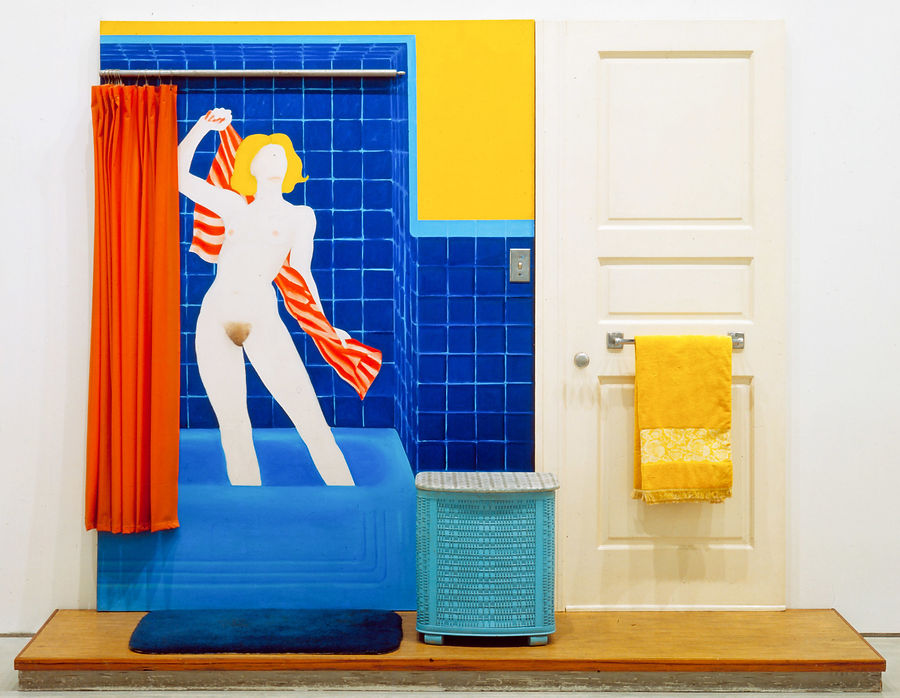
TOM WESSELMAN
BATHTUB COLLAGE NO. 3.19( Cologne. Ludwig Musei

Thomas K. Wesselmann (February 23, 1931 – December 17, 2004) was an American artist associated with the Pop Art movement who worked in painting, collage and sculpture.
Wesselmann was born in Cincinnati.
From 1949 to 1951 he attended college in Ohio; first at Hiram College, and then transferred to major in Psychology at the University of Cincinnati. He was drafted into the US Army in 1952, but spent his service years stateside. During that time he made his first cartoons, and became interested in pursuing a career in cartooning. After his discharge he completed his psychology degree in 1954, whereupon he began to study drawing at the Art Academy of Cincinnati. He achieved some initial success when he sold his first cartoon strips to the magazines 1000 Jokes and True.
Cooper Union accepted him in 1956, and he continued his studies in New York. During a visit to the MoMA he was inspired by the Robert Motherwell painting Elegy to the Spanish Republic: “The first aesthetic experience… He felt a sensation of high visceral excitement in his stomach, and it seemed as though his eyes and stomach were directly connected”.
Wesselmann also admired the work of Willem de Kooning, but he soon rejected action painting: “He realized he had to find his own passion he felt he had to deny to himself all that he loved in de Kooning, and go in as opposite a direction as possible."
For Wesselmann, 1958 was a pivotal year. A landscape painting trip to Cooper Union's Green Camp in rural New Jersey, brought him to the realization that he could pursue painting, rather than cartooning, as a career.

Tom Wesselmann
Cut-Out Nude Study, 1965

Tom Wesselmann
Great American Nude no.73
1965

Tom Wesselmann
Great American Nude
1961

Tom Wesselmann
Great American Nude
1961

Tom Wesselmann
Great American Nude

Tom Wesselmann
Great American Nude no. 44
1963

Tom Wesselmann
Great American Nude

Tom Wesselmann
Great American Nude no. 21
1961

Tom Wesselmann
Great American Nude no.34
1962

Tom Wesselmann
The Great American Nude #26

Tom Wesselmann
Bathtub Collage #2
(1963)

Tom Wesselmann
Bathtub Collage #4
(1964)

Tom Wesselmann
"Bathroom"
1931

Tom Wesselmann
1960-1965 series “Great American Nude”

Tom Wesselmann
1960-1965 series “Great American Nude”

Tom Wesselmann
1960-1965 series “Great American Nude”

Tom Wesselmann
1960-1965 series “Great American Nude”

Tom Wesselmann
1960-1965 series “Great American Nude”

Tom Wesselmann
"Great American Nude (10)"

Tom Wesselmann
Great American Nude #36

Tom Wesselmann
Great American Nude

Tom Wesselmann
Great American Nude no.49
1963

Tom Wesselmann
Great American Nude
1965

Tom Wesselmann
Great American Nude
1965

Tom Wesselmann
Great American Nude n.45
1963

Tom Wesselmann
Great American Nude n.8
1961

Tom Wesselmann
Great American Nude n.9
1961

Tom Wesselmann
Great American Nude n.34
1962

Tom Wesselmann,
«Great American Nude #27»,
1962

Tom Wesselmann
Great American Nude #35,
1962

Tom Wesselmann
Great American Nude n.93
1965

Tom Wesselmann
Great American Nude n.54
1964
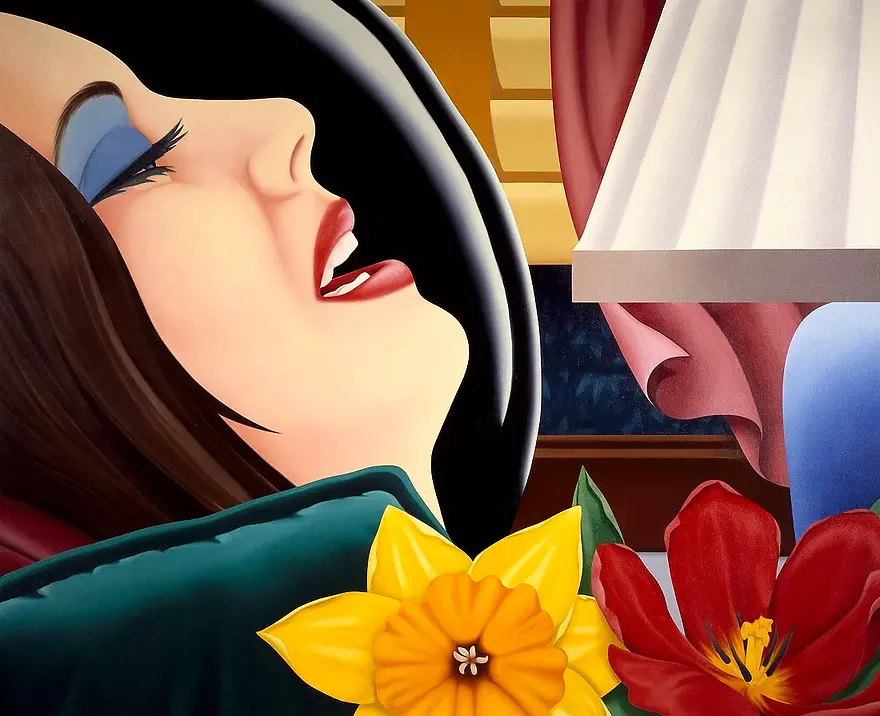
Tom Wesselmann
1960-1965 series “Great American Nude”

Tom Wesselmann
1960-1965 series “Great American Nude”
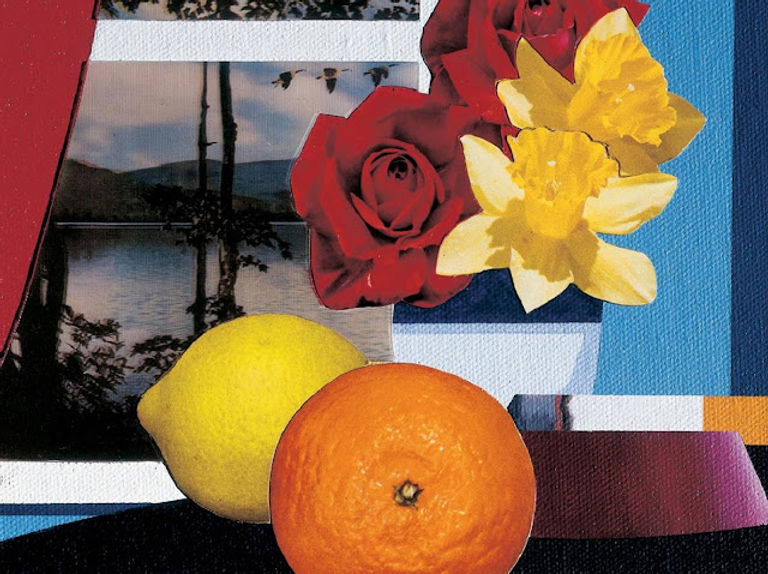
Tom Wesselmann
Untitled

Tom Wesselmann
Untitled
Marjorie Strider
1931 – 2014

Marjorie Strider
Marjorie Virginia Strider (January 26, 1931 – August 27, 2014) was an American painter, sculptor and performance artist best known for her three-dimensional paintings and site-specific soft sculpture installations.
Born in 1931 in Guthrie, Oklahoma, Strider studied art at the Kansas City Art Institute before moving to New York City in the early 1960s. Strider's three-dimensional paintings of beach girls with "built out" curves were prominently featured in the Pace Gallery's 1964 "International Girlie Show" alongside other "pin-up"-inspired pop art by Rosalyn Drexler, Roy Lichtenstein, Andy Warhol, and Tom Wesselmann. Her comically pornographic Woman with Radish was made into the banner image for the show, one of the first successful exhibitions of the then-new gallery. Her bold figural work from this era aimed to subvert sexist images of women in popular culture by turning objectified female bodies into menacing forms that literally got "in your face." Strider had two subsequent solo exhibitions at the Pace Gallery in 1965 and 1966 where she continued to show her voluminous paintings of bikini-clad girls as well as 3-D renderings of vegetables, fruits, flowers, clouds and other natural phenomena.
Strider became a core member of the 1960s avant-garde. She performed in happenings organized by Allan Kaprow, Claes Oldenburg and others. In 1969 she organized with Hannah Weiner and John Perreault the first Street Work, an informal public art event. Twenty artists participated including Vito Acconci, Gregory Battcock and Arakawa. Strider's contribution was thirty empty picture frames which she hung in random locations in Midtown Manhattan in the hopes of getting pedestrians to look at their environment differently. Strider married Michael Kirby, a contemporary artist and writer who published the first book on happenings in 1965.
Around this time Strider made chocolate casts of Patty Oldenburg's breasts for Claes's birthday (a plaster version was later acquired by Sol LeWitt). Perhaps it was her intimate friendship with the Oldenburgs that led Strider to redirect her artistic focus from hard sculptural paintings to soft sculpture in the 1970s. She made site-specific installations of unbridled polyurethane foam that tumbled out of windows (Building Work 1976, PS1) or oozed down a spiral staircase (Blue Sky 1976, Clocktower Gallery). At times her renegade pours incorporated domestic objects (brooms, groceries, teapots), while others remained totally amorphous. These works are similar in style and intent to Lynda Benglis' floor paintings and soft sculptures of the same era.
From 1982 to 1985, a retrospective of her work toured museums and universities across the United States. Venues included: SculptureCenter, New York; Gibbes Museum of Art, Charleston, South Carolina; Joslyn Art Museum, Omaha, Nebraska; Museum of Art, University of Arizona, Tucson; and the McNay Art Museum, San Antonio, Texas. In the 1990s, she began to make paintings with tactile surfaces that were more Abstract Expressionist than Pop. In 2009 she revisited her original girlie theme, painting new examples which she exhibited at the Bridge Gallery, New York.
Marjorie Strider died at her home in Saugerties, New York, on August 27, 2014.

Marjorie Strider

Marjorie Strider

Marjorie Strider

Marjorie Strider

Marjorie Strider

Marjorie Strider

Marjorie Strider

Marjorie Strider

Marjorie Strider

Marjorie Strider
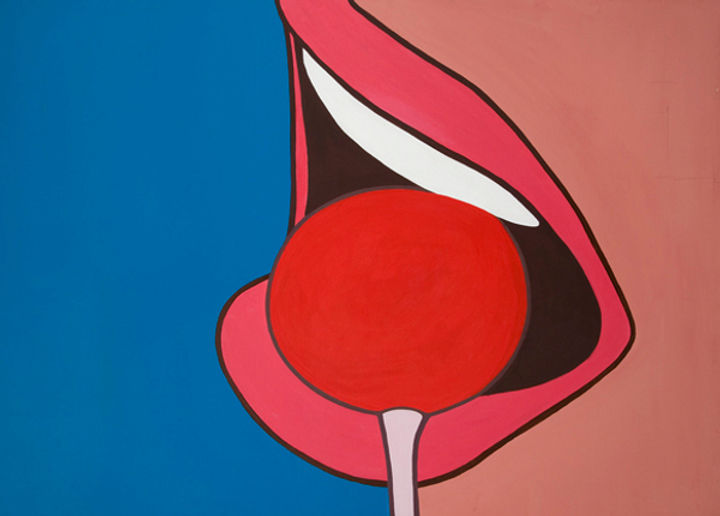
Marjorie Strider

Marjorie Strider

Marjorie Strider

Marjorie Strider

Marjorie Strider

Marjorie Strider

Marjorie Strider

Marjorie Strider

Marjorie Strider

Marjorie Strider
Audrey Flack
b.1931
Audrey Flack
(born May 30, 1931) is an American artist. Her work pioneered the art genre of photorealism and encompasses painting, printmaking, sculpture, and photography.
Flack has numerous academic degrees, including both a graduate and an honorary doctorate degree from Cooper Union in New York City. Additionally she has a bachelor's degree in Fine Arts from Yale University and attended New York University Institute of Fine Arts where she studied art history. In May 2015, Flack received an honorary Doctor of Fine Arts degree from Clark University, where she also gave a commencement address.
Flack's work is displayed in several major museums, including the Museum of Modern Art, the Metropolitan Museum of Art, Smithsonian American Art Museum, the Whitney Museum of American Art, and the Solomon R. Guggenheim Museum. Flack's photorealistic paintings were the first such paintings to be purchased for the Museum of Modern Art's permanent collection, and her legacy as a photorealist lives on to influence many American and International artists today. J. B. Speed Art Museum in Louisville, Kentucky, organized a retrospective of her work, and Flack's pioneering efforts into the world of photorealism popularized the genre to the extent that it remains today.

Audrey Flack

Audrey Flack

Audrey Flack

Audrey Flack

Audrey Flack

Audrey Flack

Audrey Flack

Audrey Flack

Audrey Flack

Audrey Flack

Audrey Flack

Audrey Flack

Audrey Flack

Audrey Flack

Audrey Flack

Audrey Flack

Audrey Flack

Audrey Flack

Audrey Flack
Erro
b.1932

ERRO:
PICASSO-ANTIBES. 1982. Antibes. Musée Picasso

Erro
Erró
(born Guðmundur Guðmundsson in 1932 in Ólafsvík, Iceland) is a visual artist and painter, who is best known for his painted pop art collages of images from comic books and advertisements. He lives in France and Spain.
Erró studied art in Norway and in Italy, and has resided in Paris, Thailand, and on the island of Formentera for most of his life. In 1989 he donated a large collection of his works to the Reykjavik Arts Museum, which has put part of it on permanent display and opened a website where the whole collection can be visited.

The Second Scream
Erro
1967

Pop Queen
Erro
1967

Chinese Petroleum
Erro
1978

Franz Liszt
Erro
1980

The Terrorist
Erro

Facing the Wild Cats
Erro

Eggfu.
Erro

Le Mirroir.
Erro

Brother.
Erro

Feminine King-Kong.
Erro

Heartbreakers.
Erro
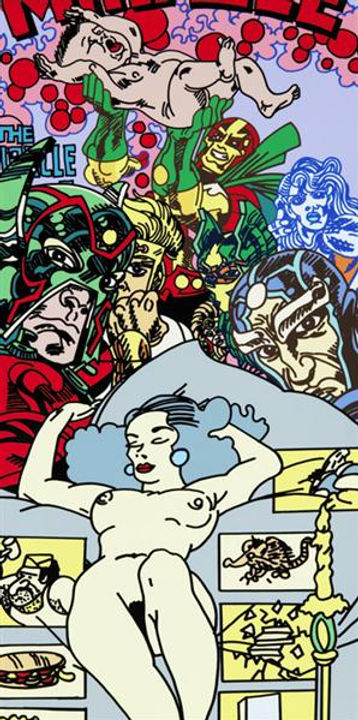
The Dream.
Erro

Urban Beauty Show.
Erro

Breakfast with Bullfighter
Erro

Marilyn and the old man
Erro
Peter Blake
b.1932

Peter Blake
Sir Peter Thomas Blake (born 25 June 1932) is an English pop artist. He co-created the sleeve design for the Beatles' 1967 album Sgt. Pepper's Lonely Hearts Club Band. His other works include the covers for two of The Who's albums, the cover of the Band Aid single "Do They Know It's Christmas?", and the Live Aid concert poster. Blake also designed the 2012 Brit Award statuette.
Blake is a prominent figure in the pop art movement. Central to his paintings are his interest in images from popular culture which have infused his collages. In 2002 he was knighted at Buckingham Palace for his services to art.
Peter Blake was born in Dartford, Kent, on 25 June 1932. He was educated at the Gravesend Technical College school of art, and the Royal College of Art.
From the late 1950s, Blake's paintings included imagery from advertisements, music hall entertainment, and wrestlers, often including collaged elements. Blake was included in group exhibitions at the Institute of Contemporary Arts. In the "Young Contemporaries" exhibition of 1961 in which he exhibited alongside David Hockney and R. B. Kitaj, he was first identified with the emerging British Pop Art movement. Blake won the (1961) John Moores junior award for Self Portrait with Badges. He came to wider public attention when, along with Pauline Boty, Derek Boshier and Peter Phillips, he featured in Ken Russell's Monitor film on pop art, Pop Goes the Easel, broadcast on BBC television in 1962. From 1963, Blake was represented by Robert Fraser placing him at the centre of Swinging London and bringing him into contact with leading figures of popular culture. Blake had his first solo exhibition with Robert Fraser Gallery in 1965 and appeared on the front cover of LIFE International in a photograph by Lord Snowdon.[4] Blake was given the final exhibition held at Robert Fraser Gallery which closed in 1969. The same year, Blake had his first exhibition with Waddington Galleries, owned by Leslie Waddington who became his lifelong supporter and representative. In 1999, Blake painted Leslie Waddington with Portrait of a Young Man by Hans Memling.
Blake participated in Prince Edward's charity television special The Grand Knockout Tournament in 1987.

On the Balcony
Peter Blake
1955 - 1957

Tuesday
Peter Blake
1961

The Toy Shop
Peter Blake
1962

Portrait of David Hockney in a Hollywood Spanish Interior
Peter Blake
1965
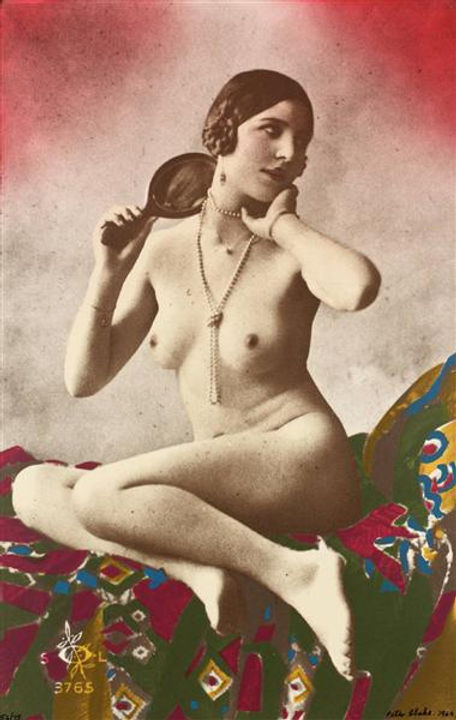
3675
Peter Blake
1969

J.A.
Peter Blake
1969

Leo 79
Peter Blake
1969

Serie 83
Peter Blake
1969
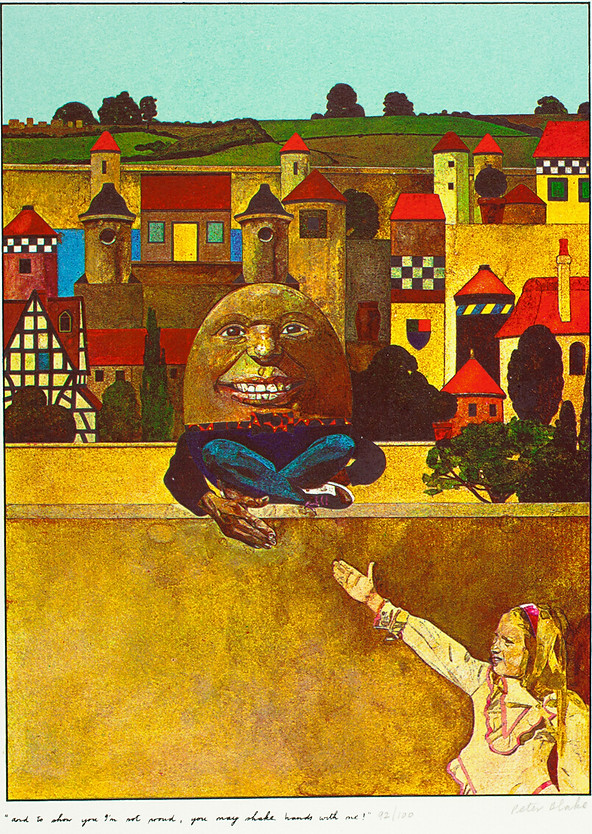
'and to show you I'm not proud, you may shake hands with me!'
Peter Blake
1970

'But isn't it old!' Tweedledum cried
Peter Blake
1970

'For instance now, now there's the King's messenger'
Peter Blake
1970

'It isn't manners for us to begin, you know', said the Rose
Peter Blake
1970

So Alice picked him up very gently
Peter Blake
1970

'Well, this is grand!' said Alice
Peter Blake
1970

Studio Tack-Board
Peter Blake
1972

N is for nude silkscreen by Peter Blake

Peter Blake, Images for Under Milk Wood by Dylan Thomas
James Rosenquist
1933 – 2017
.jpg)
James Albert Rosenquist
(November 29, 1933 – March 31, 2017) was an American artist and one of the proponents of the pop art movement. Drawing from his background working in sign painting, Rosenquist's pieces often explored the role of advertising and consumer culture in art and society, utilizing techniques he learned making commercial art to depict popular cultural icons and mundane everyday objects. While his works have often been compared to those from other key figures of the pop art movement, such as Andy Warhol and Roy Lichtenstein, Rosenquist's pieces were unique in the way that they often employed elements of surrealism using fragments of advertisements and cultural imagery to emphasize the overwhelming nature of ads. He was a 2001 inductee into the Florida Artists Hall of Fame.

JAMES ROSENQUIST:
THE PRESIDENT-ELECT. 1960

JAMES ROSENQUIST:
THE PRESIDENT-ELECT. 1960

James Rosenquist
The Swimmer in the Econo-mist (painting 3)

James Rosenquist
World’s Fair Mural, 1964

James Rosenquist
Painting for the American Negro
1962-1963
.jpg)
James Rosenquist "Silver Skys”
.jpg)
James Rosenquist "Frosting”
.jpg)
James Rosenquist "Vestigial Appendage”
.jpg)
James Rosenquist "Vestigial Appendage”
.jpg)
James Rosenquist "Brandels On Democracy ”
.jpg)
James Rosenquist "I Love You W My Ford"
.jpg)
James Rosenquist
"Woman I”

JAMES ROSENQUIST, MARILYN MONROE, 1962, MUSEO ARTE MODERNO DE NEW YORK

James Rosenquist “Marilyn”
.jpg)
Robert Rauschenberg “The Magician ”
.jpg)
James Rosenquist "Nomad”

James Rosenquist
House of Fire